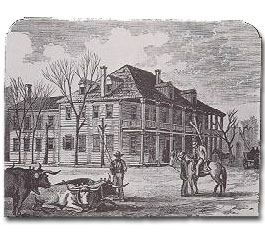OUR LEGACY - Early Houston
 In June 1837, Houston was incorporated as a city with some 1,200 residents. It rapidly developed as a trade center for agricultural products, cotton, lumber and hides from the surrounding areas. Still, for some time to come, Buffalo Bayou did not reach the town until the 1850's.
In June 1837, Houston was incorporated as a city with some 1,200 residents. It rapidly developed as a trade center for agricultural products, cotton, lumber and hides from the surrounding areas. Still, for some time to come, Buffalo Bayou did not reach the town until the 1850's.
By the end of 1837, Houston had its first courthouse and jail. In 1838, John Carlos opened the city's first theater. In 1839, as the population of the city approached 3,000, the first public school was opened. Harrisburg County, established three years before, was renamed Harris County with Houston as county seat. The Allen's dream was fast becoming a reality.
Although he lived to see his town take its place as the national and local seat of government, John K. Allen died in 1838 of congestive fever. He was twenty-nine years old. The brilliant entrepreneur was spared the bitter disappointment that Houstonians were dealt by the 1839 congressional decision which moved the republic's seat of government to Austin in the Texas Hill Country, where the republic's congress met the following year. Heat, humidity, mosquitoes and other discomforts that plagued the legislators in addition to the absence of promised facilities in Houston, were cited as the reasons for the move.
Well into the 1840's, Houston looked like a frontier town, featuring characteristics of both the slower-paced South and the wild West. Besides these, the city had all the elements that later figured in its rise to pre-eminence in the state and in the country: hope, opportunity, ambition, enterprise, courage, innocence and youthful vitality.
Houston saw racial tension as well. Many of the early colonizers had built plantations and owned black slaves. Indeed, one of the underlying reasons for rebellion against Mexico was the outlawing, in 1830, of the importation of more slaves. The slave trade, active in Houston until the 1860's, contributed significantly to the initial settlement of East Texas.
The Indians, however, were friendly toward the whites; the Cherokees had conferred upon the republic's first president, and city's namesake, the title of "Honorary Chief." A few Cherokees lived on the north side of Houston, and occasionally did business at Kennedy's Trading Post.
In January 1840, at a time of economic crisis, a group of thriving businessmen established the Chamber of Commerce to help improve the business atmosphere. In 1841, a city ordinance officially created the Port of Houston, and the long task of improving the bayou for navigation began. By 1842, the Houston area population exceeded 4,700. Sam Houston, serving his second term as president of Texas, temporarily returned the seat of government to Houston that year, after Mexican troops invaded the republic and threatened the lawmakers in Austin. Meanwhile, receipt from the export of cotton continuously rose. Trade, rather than manufacturing, proved instrumental in the city's early growth.
Houston's city fathers built their city hall in the block that was designated as Congress Square on the original map; since the site of the capital was moved, the Allens never completed the planned government structures. Congress Square remained unbuilt and became a convenient spot at which farmers from the surrounding area sold their goods. People began calling the area Market Square, and it later served as the site of a succession of commercial enterprises.
Typical of the early successful merchants, Thomas William House rose from his beginnings as a banker, who did some money lending as a sideline, to become a cotton magnate, banker and investor in railroads and public utilities. During the Civil War, he transported military equipment. Both he and contemporary William Marsh Rice emerged as millionaires by the time the Civil War ended. House and Rice arrived in Houston in 1838 and became a partner in the commercial establishment of Rice and Nichols, as well as a founder of the Houston and Galveston Navigation Company. Renaming the firm the Houston Navigation Company, Rice acquired recognition as an early developer of Buffalo Bayou into a major shipping lane.






